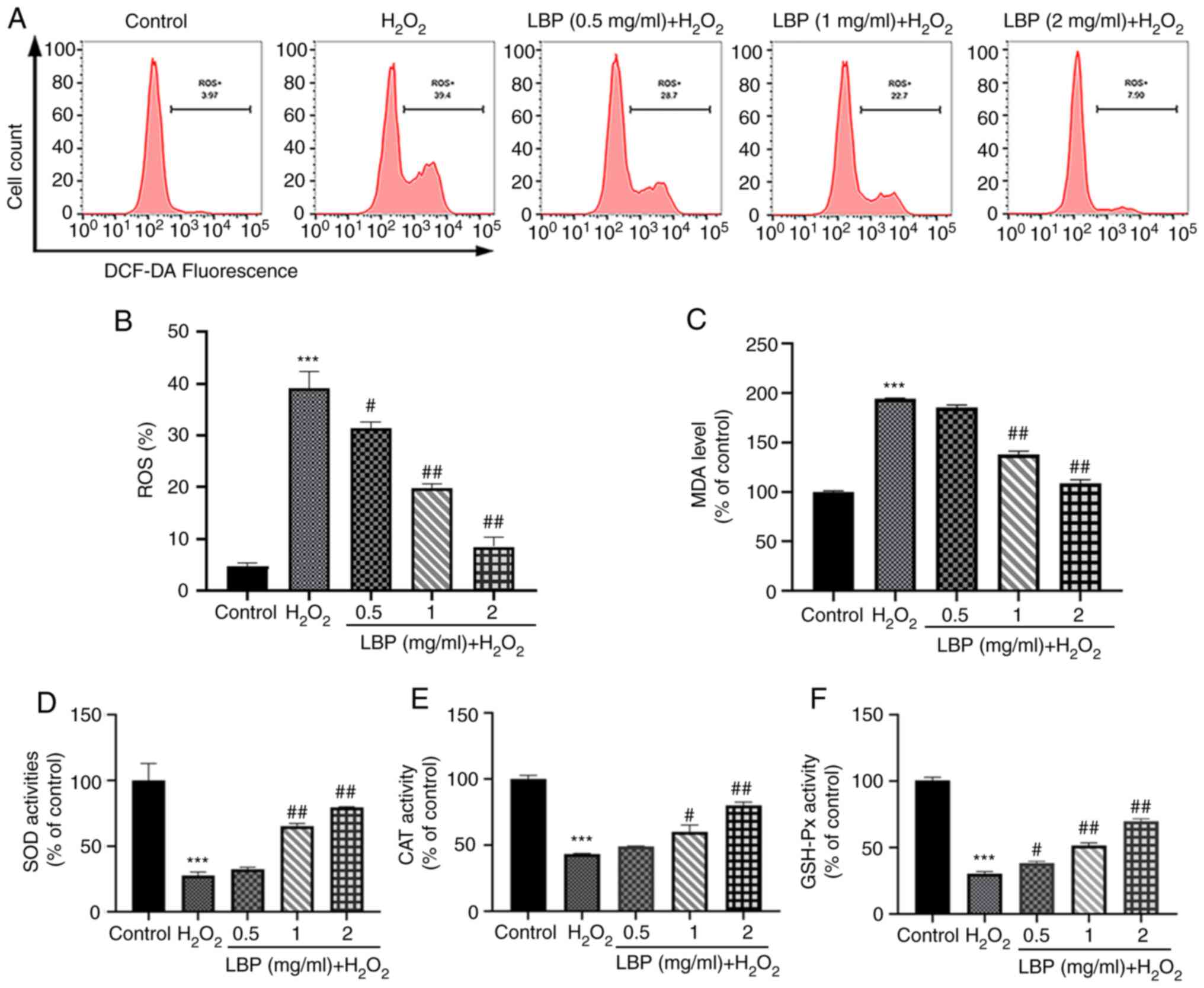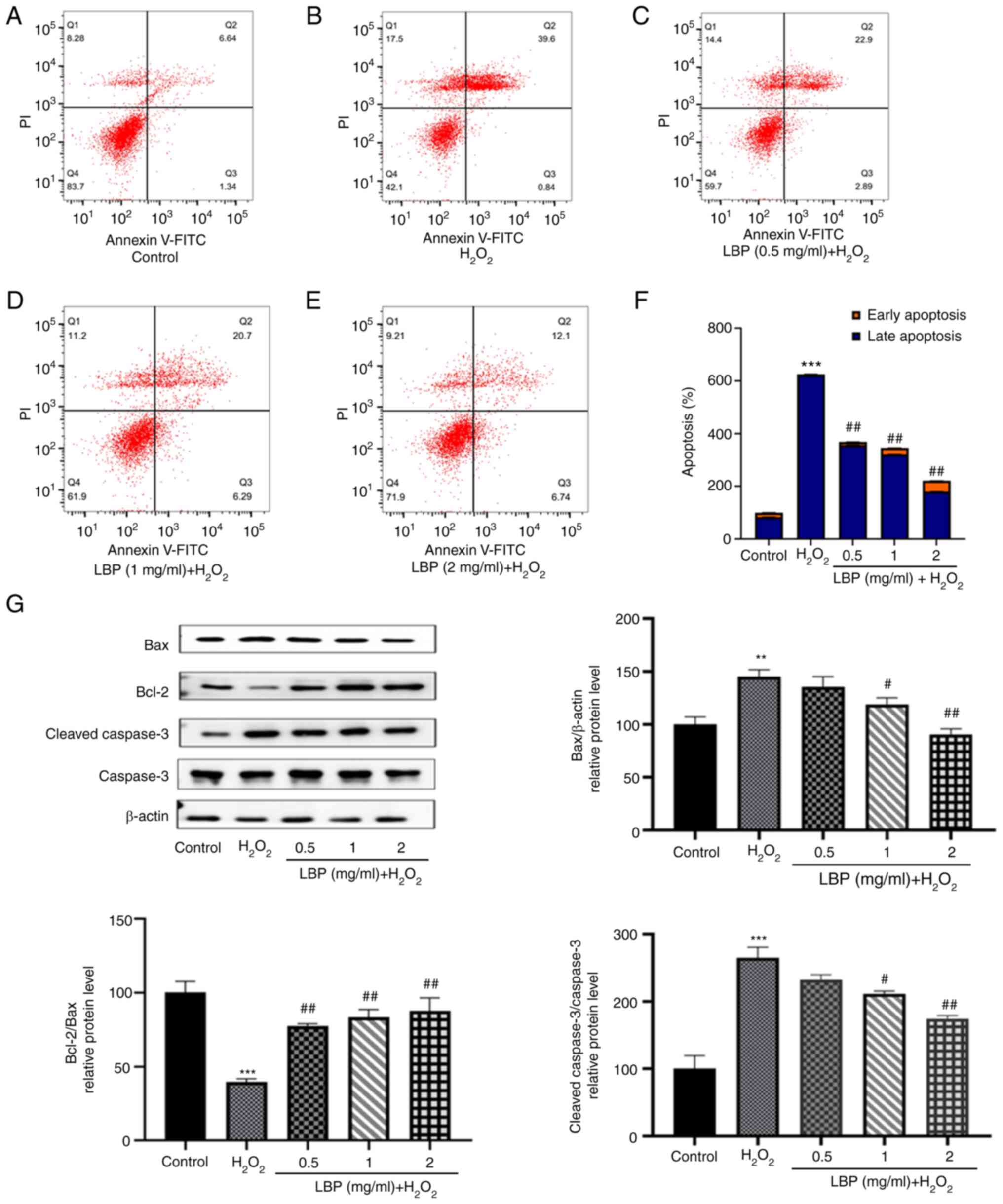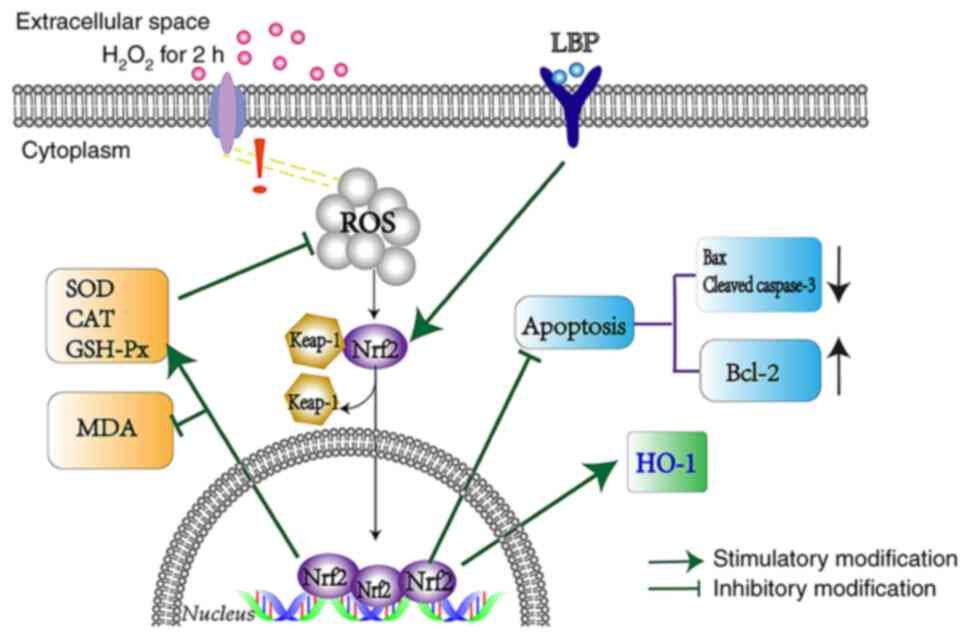|
1
|
Mitchell P, Liew G, Gopinath B and Wong
TY: Age-related macular degeneration. Lancet. 392:1147–1159. 2018.
View Article : Google Scholar : PubMed/NCBI
|
|
2
|
Yang M, So KF, Lo ACY and Lam WC: The
effect of Lycium barbarum polysaccharides on pyroptosis-associated
amyloid β1-40 oligomers-induced adult retinal pigment epithelium 19
cell damage. Int J Mol Sci. 21:46582020. View Article : Google Scholar : PubMed/NCBI
|
|
3
|
Bhutto IA, Baba T, Merges C, McLeod DS and
Lutty GA: Low nitric oxide synthases (NOSs) in eyes with
age-related macular degeneration (AMD). Exp Eye Res. 90:155–167.
2010. View Article : Google Scholar : PubMed/NCBI
|
|
4
|
Strauss O: The retinal pigment epithelium
in visual function. Physiol Rev. 85:845–881. 2005. View Article : Google Scholar : PubMed/NCBI
|
|
5
|
Anderson RE, Rapp LM and Wiegand RD: Lipid
peroxidation and retinal degeneration. Curr Eye Res. 3:223–227.
1984. View Article : Google Scholar : PubMed/NCBI
|
|
6
|
Catalá A: An overview of lipid
peroxidation with emphasis in outer segments of photoreceptors and
the chemiluminescence assay. Int J Biochem Cell Biol. 38:1482–1495.
2006. View Article : Google Scholar : PubMed/NCBI
|
|
7
|
Cai J, Nelson KC, Wu M, Sternberg P Jr and
Jones DP: Oxidative damage and protection of the RPE. Prog Retin
Eye Res. 19:205–221. 2000. View Article : Google Scholar : PubMed/NCBI
|
|
8
|
Bellezza I, Giambanco I, Minelli A and
Donato R: Nrf2-Keap1 signaling in oxidative and reductive stress.
Biochim Biophys Acta Mol Cell Res. 1865:721–733. 2018. View Article : Google Scholar : PubMed/NCBI
|
|
9
|
Kobayashi M and Yamamoto M: Molecular
mechanisms activating the Nrf2-Keap1 pathway of antioxidant gene
regulation. Antioxid Redox Signal. 7:385–394. 2005. View Article : Google Scholar : PubMed/NCBI
|
|
10
|
Shelton LM, Kevin Park B and Copple IM:
Role of Nrf2 in protection against acute kidney injury. Kidney Int.
84:1090–1095. 2013. View Article : Google Scholar : PubMed/NCBI
|
|
11
|
Zhou J, Chen F, Yan A and Xia X:
Madecassoside protects retinal pigment epithelial cells against
hydrogen peroxide-induced oxidative stress and apoptosis through
the activation of Nrf2/HO-1 pathway. Biosci Rep.
40:BSR201943472020. View Article : Google Scholar : PubMed/NCBI
|
|
12
|
Cameron BD, Sekhar KR, Ofori M and Freeman
ML: The role of Nrf2 in the response to normal tissue radiation
injury. Radiat Res. 190:99–106. 2018. View Article : Google Scholar : PubMed/NCBI
|
|
13
|
Liu W, Liu Y, Zhu R, Yu J, Lu W, Pan C,
Yao W and Gao X: Structure characterization, chemical and enzymatic
degradation, and chain conformation of an acidic polysaccharide
from Lycium barbarum L. Carbohydr Polym. 147:114–124. 2016.
View Article : Google Scholar : PubMed/NCBI
|
|
14
|
Qi B, Ji Q, Wen Y, Liu L, Guo X, Hou G,
Wang G and Zhong J: Lycium barbarum polysaccharides protect human
lens epithelial cells against oxidative stress-induced apoptosis
and senescence. PLoS One. 9:e1102752014. View Article : Google Scholar : PubMed/NCBI
|
|
15
|
Pan H, Shi Z, Yang TG, Yu LM and Xu AL:
The protective effects of lycium barbarum polysaccharides on
retinal neurons in diabetic rats and its mechanism. Zhongguo Ying
Yong Sheng Li Xue Za Zhi. 35:55–59. 2019.(In Chinese). PubMed/NCBI
|
|
16
|
Curcio CA, Zanzottera EC, Ach T,
Balaratnasingam C and Freund KB: Activated retinal pigment
epithelium, an optical coherence tomography biomarker for
progression in age-related macular degeneration. Invest Ophthalmol
Vis Sci. 58:BIO211–BIO226. 2017.PubMed/NCBI
|
|
17
|
Kopitz J, Holz FG, Kaemmerer E and Schutt
F: Lipids and lipid peroxidation products in the pathogenesis of
age-related macular degeneration. Biochimie. 86:825–831. 2004.
View Article : Google Scholar : PubMed/NCBI
|
|
18
|
Li S, Gaur U, Chong CM, Lin S, Fang J,
Zeng Z, Wang H and Zheng W: Berberine protects human retinal
pigment epithelial cells from hydrogen peroxide-induced oxidative
damage through activation of AMPK. Int J Mol Sci. 19:17362018.
View Article : Google Scholar : PubMed/NCBI
|
|
19
|
Golestaneh N, Chu Y, Xiao YY, Stoleru GL
and Theos AC: Dysfunctional autophagy in RPE, a contributing factor
in age-related macular degeneration. Cell Death Dis. 8:e25372017.
View Article : Google Scholar : PubMed/NCBI
|
|
20
|
Golestaneh N, Chu Y, Cheng SK, Cao H,
Poliakov E and Berinstein DM: Repressed SIRT1/PGC-1α pathway and
mitochondrial disintegration in iPSC-derived RPE disease model of
age-related macular degeneration. J Transl Med. 14:3442016.
View Article : Google Scholar : PubMed/NCBI
|
|
21
|
Mi XS, Chiu K, Van G, Leung JW, Lo AC,
Chung SK, Chang RC and So KF: Effect of Lycium barbarum
Polysaccharides on the expression of endothelin-1 and its receptors
in an ocular hypertension model of rat glaucoma. Neural Regen Res.
7:645–651. 2012.PubMed/NCBI
|
|
22
|
Li SY, Yang D, Yeung CM, Yu WY, Chang RC,
So KF, Wong D and Lo AC: Lycium barbarum polysaccharides reduce
neuronal damage, blood-retinal barrier disruption and oxidative
stress in retinal ischemia/reperfusion injury. PLoS One.
6:e163802011. View Article : Google Scholar : PubMed/NCBI
|
|
23
|
Yao Q, Yang Y, Lu X, Zhang Q, Luo M, Li PA
and Pan Y: Lycium barbarum polysaccharides improve retinopathy in
diabetic sprague-dawley rats. Evid Based Complement Alternat Med.
2018:79432122018. View Article : Google Scholar : PubMed/NCBI
|
|
24
|
Varoni MV, Pasciu V, Gadau SD, Baralla E,
Serra E, Palomba D and Demontis MP: Possible antioxidant effect of
Lycium barbarum polysaccharides on hepatic cadmium-induced
oxidative stress in rats. Environ Sci Pollut Res Int. 24:2946–2955.
2017. View Article : Google Scholar : PubMed/NCBI
|
|
25
|
Chen L, Li W, Qi D and Wang D: Lycium
barbarum polysaccharide protects against LPS-induced ARDS by
inhibiting apoptosis, oxidative stress, and inflammation in
pulmonary endothelial cells. Free Radic Res. 52:480–490. 2018.
View Article : Google Scholar : PubMed/NCBI
|
|
26
|
Schoppet M, Tailhades J, Kulkarni K and
Cryle MJ: Precursor manipulation in glycopeptide antibiotic
biosynthesis: Are β-amino acids compatible with the oxidative
cyclization cascade? J Org Chem. 83:7206–7214. 2018. View Article : Google Scholar : PubMed/NCBI
|
|
27
|
Kaczara P, Sarna T and Burke JM: Dynamics
of H2O2 availability to ARPE-19 cultures in models of oxidative
stress. Free Radic Biol Med. 48:1064–1070. 2010. View Article : Google Scholar : PubMed/NCBI
|
|
28
|
Geiger RC, Waters CM, Kamp DW and
Glucksberg MR: KGF prevents oxygen-mediated damage in ARPE-19
cells. Invest Ophthalmol Vis Sci. 46:3435–3442. 2005. View Article : Google Scholar : PubMed/NCBI
|
|
29
|
Zareba M, Raciti MW, Henry MM, Sarna T and
Burke JM: Oxidative stress in ARPE-19 cultures: Do melanosomes
confer cytoprotection? Free Radic Biol Med. 40:87–100. 2006.
View Article : Google Scholar : PubMed/NCBI
|
|
30
|
Zhao H, Wang R, Ye M and Zhang L: Genipin
protects against H2O2-induced oxidative damage in retinal pigment
epithelial cells by promoting Nrf2 signaling. Int J Mol Med.
43:936–944. 2019.PubMed/NCBI
|
|
31
|
Pintea A, Rugină DO, Pop R, Bunea A and
Socaciu C: Xanthophylls protect against induced oxidation in
cultured human retinal pigment epithelial cells. J Food Compos
Anal. 24:830–836. 2011. View Article : Google Scholar
|
|
32
|
Musat O, Ochinciuc U, Gutu T, Cristescu TR
and Coman C: Pathophysiology and treatment of ARMD. Oftalmologia.
56:45–50. 2012.(In Romanian). PubMed/NCBI
|
|
33
|
Qu S, Zhang C, Liu D, Wu J, Tian H, Lu L,
Xu GT, Liu F and Zhang J: Metformin protects ARPE-19 cells from
glyoxal-induced oxidative stress. Oxid Med Cell Longev.
2020:17409432020.PubMed/NCBI
|
|
34
|
Sakai E, Shimada-Sugawara M, Yamaguchi Y,
Sakamoto H, Fumimoto R, Fukuma Y, Nishishita K, Okamoto K and
Tsukuba T: Fisetin inhibits osteoclastogenesis through prevention
of RANKL-induced ROS production by Nrf2-mediated up-regulation of
phase II antioxidant enzymes. J Pharmacol Sci. 121:288–298. 2013.
View Article : Google Scholar : PubMed/NCBI
|
|
35
|
Jiang P, Chen L, Sun J, Li J, Xu J, Liu W,
Feng F and Qu W: Chotosan ameliorates cognitive impairment and
hippocampus neuronal loss in experimental vascular dementia via
activating the Nrf2-mediated antioxidant pathway. J Pharmacol Sci.
139:105–111. 2019. View Article : Google Scholar : PubMed/NCBI
|
|
36
|
Xiong GF, Li DW, Zheng MB and Liu SC: The
effects of Lycium barbarum polysaccharide (LBP) in a mouse model of
cerulein-induced acute pancreatitis. Med Sci Monit. 25:3880–3886.
2019. View Article : Google Scholar : PubMed/NCBI
|
|
37
|
Huang Y, Zhou F, Shen C, Wang H and Xiao
Y: LBP reduces theinflammatory injuryof kidney in septic rat and
regulates the Keap1-Nrf2/ARE signaling pathway1. Acta Cir Bras.
34:e201900100000032019. View Article : Google Scholar : PubMed/NCBI
|
|
38
|
Chen B, Lu Y, Chen Y and Cheng J: The role
of Nrf2 in oxidative stress-induced endothelial injuries. J
Endocrinol. 225:R83–R99. 2015. View Article : Google Scholar : PubMed/NCBI
|
|
39
|
Hiramatsu K, Tsuneyoshi T, Ogawa T and
Morihara N: Aged garlic extract enhances heme oxygenase-1 and
glutamate-cysteine ligase modifier subunit expression via the
nuclear factor erythroid 2-related factor 2-antioxidant response
element signaling pathway in human endothelial cells. Nutr Res.
36:143–149. 2016. View Article : Google Scholar : PubMed/NCBI
|
|
40
|
Hao Y, Liu J, Wang Z, Yu LL and Wang J:
Piceatannol protects human retinal pigment epithelial cells against
hydrogen peroxide induced oxidative stress and apoptosis through
modulating PI3K/Akt signaling pathway. Nutrients. 11:15152019.
View Article : Google Scholar : PubMed/NCBI
|
|
41
|
Cao S, Du J and Hei Q: Lycium barbarum
polysaccharide protects against neurotoxicity via the Nrf2-HO-1
pathway. Exp Ther Med. 14:4919–4927. 2017.PubMed/NCBI
|



















